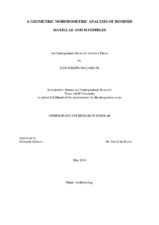| dc.creator | Magaro, Jude Joseph | |
| dc.date.accessioned | 2016-09-05T14:31:46Z | |
| dc.date.available | 2016-09-05T14:31:46Z | |
| dc.date.created | 2014-05 | |
| dc.date.issued | 2013-09-26 | |
| dc.date.submitted | May 2014 | |
| dc.identifier.uri | https://hdl.handle.net/1969.1/157608 | |
| dc.description.abstract | Fossil mandibular elements assigned to the taxon Australopithecus sediba were found at Malapa, South Africa. The mandibular elements have since been used to create a fully reconstructed version of the mandible of the animal. In order to better understand how fossil species separate with jaw bones an analysis will be done on extant species of great apes, gibbons, and humans. If the jaw bones do separate as expected it will be possible to then diagnose species based on jaw bone data, particularly if only data from one of the jaw bones is available. | en |
| dc.format.mimetype | application/pdf | |
| dc.subject | Morphometrics, Paleoanthropology | en |
| dc.title | A GEOMETRIC MORPHOMETRIC ANALYSIS OF HOMINID MAXILLAE AND MANDIBLES | en |
| dc.type | Thesis | en |
| thesis.degree.department | Anthropology | en |
| thesis.degree.discipline | Anthropology | en |
| thesis.degree.grantor | Undergraduate Research Scholars Program | en |
| dc.contributor.committeeMember | DE RUITER, DARRYL | |
| dc.type.material | text | en |
| dc.date.updated | 2016-09-05T14:31:46Z | |


